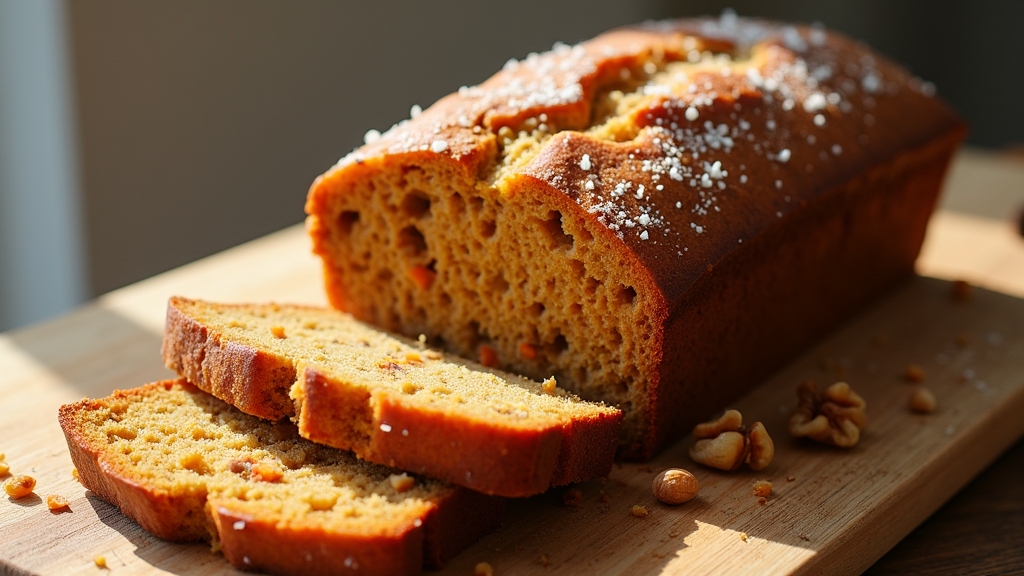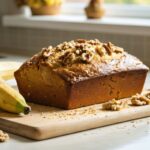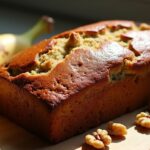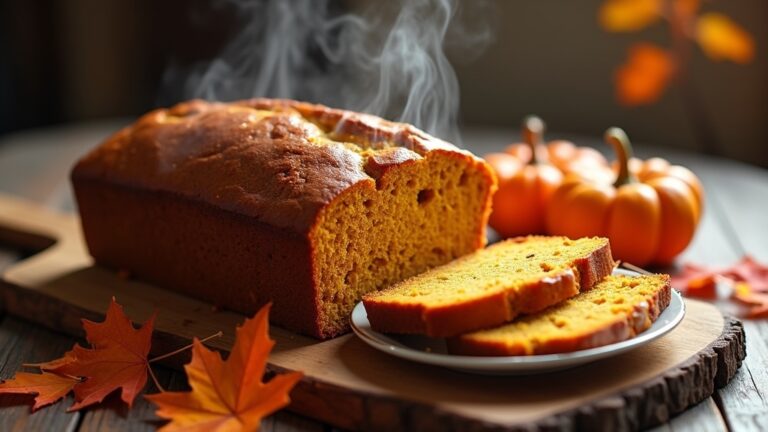Carrot Bread Recipe
I love making carrot bread because it’s so simple and delicious! You just mix together 1 ½ cups of flour, 1 cup of grated carrots, 1 cup of sugar, ½ cup of vegetable oil, and 2 eggs. Bake at 350°F for 50-60 minutes, and you’ll have a moist and flavorful loaf. It’s perfect for breakfast or a snack. Plus, it’s so versatile! Stick around, and I’ll share some tips to make it even better.
Contents
History
Although many might think of carrot cake as a modern delight, the roots of carrot bread stretch back centuries, intertwining with the history of sweetening baked goods. The carrot’s origins date to ancient Persia, where its natural sugars provided a delicious alternative to refined sweeteners. As I dug deeper, I discovered the historical significance of this humble vegetable; during times of scarcity, bakers turned to carrots to create moist, flavorful loaves. This innovation not only showcased resourcefulness but also paved the way for unique flavor profiles in baking. Today, as we explore carrot bread, we celebrate its rich past while inviting fresh ideas into our kitchens—transforming a simple ingredient into something extraordinary. Isn’t it fascinating how history shapes our modern recipes?
Recipe
Carrot bread is a delightful and moist quick bread that combines the natural sweetness of carrots with warm spices to create a comforting treat perfect for breakfast or as a snack. This recipe is simple enough for novice bakers, yet it yields a deliciously satisfying result that will impress friends and family alike. With its tender crumb and subtle flavor, carrot bread is an excellent way to incorporate more vegetables into your diet without sacrificing taste.
Carrot bread is a moist, flavorful treat that brings together the sweetness of carrots and warm spices, perfect for any time of day.
Using freshly grated carrots not only adds moisture but also infuses the bread with a vibrant color and a hint of earthiness. This recipe can be easily customized by adding nuts, raisins, or even spices like nutmeg and ginger to enhance the flavor profile. Whether enjoyed plain or slathered with butter, carrot bread is sure to become a staple in your baking repertoire.
Ingredients:
- 1 ½ cups all-purpose flour
- 1 cup grated carrots
- 1 cup granulated sugar
- ½ cup vegetable oil
- 2 large eggs
- 1 teaspoon baking soda
- 1 teaspoon baking powder
- 1 teaspoon ground cinnamon
- ½ teaspoon salt
- ½ cup chopped walnuts or pecans (optional)
- ½ cup raisins (optional)
In a large mixing bowl, whisk together the flour, sugar, baking soda, baking powder, cinnamon, and salt until well combined. In another bowl, beat the eggs and mix in the vegetable oil. Add the grated carrots to the wet ingredients, stirring until everything is well combined. Gradually fold the dry ingredients into the wet mixture until just combined; be careful not to overmix. If desired, gently fold in the nuts and raisins. Pour the batter into a greased loaf pan and bake in a preheated oven at 350°F (175°C) for 50-60 minutes, or until a toothpick inserted in the center comes out clean. Allow the bread to cool in the pan for 10 minutes before transferring it to a wire rack to cool completely.
When making carrot bread, verify your grated carrots are finely shredded to achieve a smooth texture. You can enhance the flavor by adding a pinch of nutmeg or a splash of vanilla extract to the batter. If you prefer a sweeter bread, consider substituting part of the granulated sugar with brown sugar for a richer taste. Finally, for added moisture, you might experiment with adding a small amount of crushed pineapple or applesauce to the batter. Enjoy your baking!
Cooking Steps
Let’s get started on making this delicious carrot bread! First, I always preheat my oven to 350°F to guarantee it’s nice and warm when the batter goes in. Then, we’ll mix the dry ingredients thoroughly before adding the grated carrots for that sweet, earthy flavor.
Step 1. Preheat Oven to 350°F
Before diving into mixing your ingredients, I make sure to preheat my oven to 350°F. This step is essential for achieving that perfect, fluffy texture in my carrot bread. I always double-check that my oven is functioning properly, ensuring temperature accuracy—after all, even a few degrees can make a difference. While waiting for the oven to heat, I take a moment to reflect on oven safety; always handle the hot oven with care, and keep the area clear of clutter. Once the temperature reaches that sweet spot, I can confidently move forward, knowing my bread will rise beautifully and bake evenly. With a preheated oven, I’m one step closer to enjoying a delicious homemade treat!
Step 2. Mix Dry Ingredients Thoroughly
With my oven preheated to that perfect 350°F, it’s time to focus on mixing the dry ingredients for my carrot bread. This step is essential, as the dry ingredient importance cannot be overstated; they provide the structure and flavor foundation for the loaf. I sift together flour, baking powder, baking soda, and spices like cinnamon and nutmeg, ensuring they’re well combined. Using a whisk, I incorporate these elements thoroughly, employing gentle mixing techniques to avoid any clumps. This not only aerates the flour but also evenly distributes the leavening agents, setting the stage for a perfectly risen bread. With everything mixed, I’m ready to elevate my carrot bread to the next level!
Step 3. Add Grated Carrots Next
Grating the fresh carrots is a delightful step that brings vibrant color and moisture to my bread. As I grate, the sweet aroma fills the kitchen, hinting at the deliciousness to come. The grated texture of the carrots not only adds a unique look but also infuses the bread with essential nutrients. Carrots are packed with vitamins A and K, which support eye health and boost the immune system. I love how these little orange beauties elevate the flavor profile while keeping the loaf moist. Once I’ve grated enough, I can’t wait to see how their natural sweetness harmonizes with the spices. It’s an innovative twist that transforms a simple loaf into something truly special.
Step 4. Fold in Wet Ingredients
As I blend the wet ingredients into the bowl, I can already feel the bread coming to life. The magic happens when I carefully fold everything together, guaranteeing the flavors meld beautifully. Here’s how I do it:
- Whisk together the eggs, oil, and vanilla for a creamy base.
- Add in yogurt for moisture and a hint of tanginess, enhancing the flavor profile.
- Incorporate the grated carrots, letting their natural sweetness shine through.
- Combine gently to guarantee a smooth batter, focusing on texture enhancement.
This process not only incorporates flavors but also creates a delightful harmony in each bite. I can already taste the innovation that awaits in my delicious carrot bread!
Step 5. Pour Batter Into Pan
Now it’s time to pour the luscious batter into the prepared pan, and I can already smell the enticing aroma wafting through the kitchen. As I scoop the thick, velvety mixture, I check the batter consistency—it should be just right, neither too runny nor too thick. Choosing the right pan is essential; I prefer a loaf pan for that perfect shape and crust. Gently, I pour the batter, letting it settle evenly to avoid air pockets. I give it a little shake to smooth the top, ensuring it bakes uniformly. This step is vital; the right pan selection and batter consistency will elevate my carrot bread to new heights. Soon, my kitchen will be filled with the delightful scent of fresh-baked goodness!
Nutritional Guide
While enjoying a slice of homemade carrot bread, I can’t help but appreciate its nutritional benefits. This delightful treat isn’t just a feast for the taste buds; it’s also packed with essential nutrients. Carrots provide a wealth of vitamins, while the addition of whole grains can cater to various dietary variations. Here’s a quick overview of the nutritional aspects:
| Nutrient | Amount per Slice | % Daily Value |
|---|---|---|
| Calories | 150 | 7.5% |
| Fiber | 3g | 12% |
| Vitamin A | 1500 IU | 30% |
| Iron | 1mg | 6% |
| Protein | 3g | 6% |
Embracing this innovative recipe can truly enhance your health journey!
Final Thoughts
Though I’ve shared the recipe and nutritional benefits, the true joy of carrot bread lies in its ability to bring comfort and satisfaction to any moment. Whether you’re enjoying a cozy morning or sharing with friends, this treat never disappoints. Here are a few baking tips to elevate your experience:
- Experiment with ingredient substitutions—try almond flour for a gluten-free option.
- Add nuts or seeds for extra texture and flavor.
- Incorporate spices like ginger or nutmeg for a warm twist.
- Don’t hesitate to sweeten it up with maple syrup or honey for a unique taste.
Frequently Asked Questions
Can I Substitute Whole Wheat Flour for All-Purpose Flour?
Absolutely, I’ve substituted whole wheat flour for all-purpose flour before. Just keep the flour texture in mind and adjust the liquid slightly. It adds a lovely nuttiness that really enhances your baked goods.
How Should I Store Leftover Carrot Bread?
To store leftover carrot bread, I use airtight containers for the best storage. Wrapping slices in plastic wrap before placing them in these containers keeps moisture in and preserves that delightful freshness. Enjoy your innovative baking!
Can I Freeze Carrot Bread?
Absolutely, I can freeze carrot bread! For freezing tips, slice it first, wrap each piece tightly, and store in a freezer bag. When you’re ready, use thawing methods like leaving it in the fridge overnight. Enjoy!
What Type of Carrots Work Best for This Recipe?
I’ve found that vibrant, sweet carrots like Nantes or Imperator really shine in recipes. Their rich flavor profiles enhance the dish, while their nutritional benefits—packed with vitamins and antioxidants—make every bite both delicious and healthy.
Can I Add Nuts or Raisins to the Recipe?
Did you know that adding nuts can boost your dish’s protein by up to 15%? I love experimenting with different nut varieties and raisins for unique flavor combinations that elevate any recipe to a new level.
Conclusion
As I savor the last bite of this unexpected carrot bread, I can’t help but chuckle at the irony—who would’ve thought a humble vegetable could transform into such a delightful treat? It’s a reminder that sometimes, the most ordinary ingredients can yield extraordinary results. So, next time you pass by those carrots in your fridge, remember they’re not just for salads. With a bit of creativity, they can become the star of your baking adventure!









